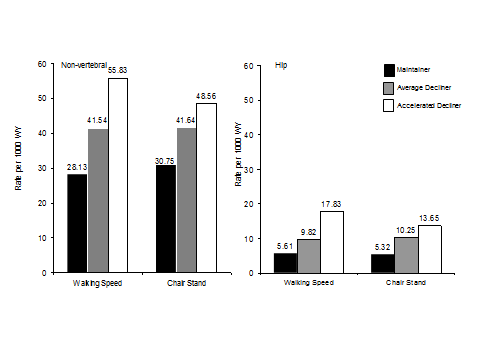Session Information
Session Type: Abstract Submissions (ACR)
Background/Purpose: Prior studies have identified poor physical function as a risk factor for fractures and mortality. However, these studies did not consider change in physical function over time. We hypothesized that women who maintain their physical function would have a lower risk of non-traumatic fracture (hip and any non-vertebral) and death.
Methods: We followed 9704 women enrolled into the Study of Osteoporotic Fractures at four U.S. clinical centers. Physical function was measured a maximum of 8 times over 19 years. The median (range) number of measurements for walking (m/s) and chair stand speed (time/s) were 6 (1-8) and 5 (1-8), respectively. Random slope and intercept models were used to determine a walking and chair stand speed slope for each woman, and for the entire population. Three groups were formed for walking speed: “maintainers” (slope ≥ -1 SD from 0, n=773, 8%); “average decliners” (1 SD below mean ≤ slope <-1 SD from 0, n=7676, 79%); “accelerated decliners” (slope >1 SD below mean, n=1255, 13%). Cox proportional hazards models were used to estimate hazard ratios (HRs; 95% CI) of fracture and mortality and control for age, BMI, physical activity, falls, fracture after age 50, diabetes, stroke, hypertension, calcium intake, health, weight change, smoking, estrogen use, and hip BMD.
Results: The HR of hip and any non-vertebral fracture was 0.64 (0.50, 0.81) and 0.76 (0.67, 0.86) for maintainers of walking speed and 1.52 (1.31, 1.76) and 1.24 (1.13, 1.36) among accelerated decliners of walking speed when compared with the average decliner group. Similar results were shown for chair stand speed. The HR of mortality was 0.49 (0.43, 0.56) for maintainers of walking speed and 0.56 (0.50, 0.64) for maintainers of chair stand speed compared with average decliner group. The HR of mortality was null for accelerated decliners of walking speed, but surprisingly 0.75 (0.70, 0.81) for accelerated decliners for chair stand speed compared with average decliners.
Conclusion: Women who maintained physical function up to 19 years experienced a lower risk of fractures and mortality than average decliners of physical function, suggesting that maintaining physical function may be a marker for healthy aging.
Figure: Fracture rate per 1000 women-year
Disclosure:
K. E. Barbour,
None;
L. Y. Lui,
None;
D. E. Barnes,
None;
K. E. Ensrud,
None;
A. B. Newman,
None;
K. Yaffe,
None;
S. R. Cummings,
None;
J. A. Cauley,
None.
« Back to 2012 ACR/ARHP Annual Meeting
ACR Meeting Abstracts - https://acrabstracts.org/abstract/trajectories-of-change-in-physical-function-effects-on-fractures-and-mortality/

